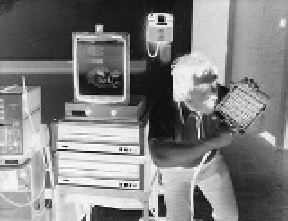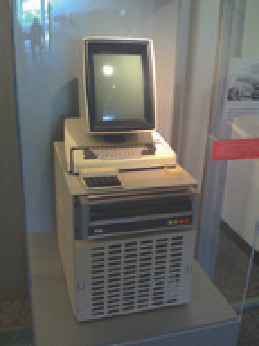Information Technology Reference
In-Depth Information
Fig. 8.24. The Xerox PARC Alto, which featured a mouse, removable data storage, networking
hardware, a visual user interface, easy-to-use graphics software, and email. The Bravo and Gypsy
word-processing software offered the user the first “What-You-See-Is-What-You-Get” or WYSIWYG
interface, with printed documents matching what users saw on screen. The Alto for the first time
combined these and other now-familiar elements in one small computer. Developed by Xerox as
a research system, the Alto marked a radical leap in the evolution of how people interact with
computers, leading the way to the environments we still have on today's computers. By making
human-computer interactions more intuitive and user friendly, the Alto opened computing to a
much wider range of users, from experts to nonspecialists, including children. People were able to
focus on using the computer as a tool to accomplish a task rather than on learning their computer's
technical details. When it was built, the revolutionary Alto would have been a very expensive per-
sonal computer if put on sale commercially. Lead engineer Charles Thacker noted that the first Alto
probably cost in the region of $12,000 to build: as a product, the price tag might have been as much
as $40,000. A decade later, Moore's law had reduced costs and personal computers with adequate
memory became affordable.
B.8.17. Alan Kay's name is closely linked with the development of personal computing. He started
college but left before graduation to join the air force. In the air force he found a new interest in
computing and when he left he enrolled at the University of Colorado. Kay graduated in 1966
with degrees in mathematics and molecular biology and went on to graduate work at the
University of Utah where he obtained an MS in electrical engineering and a PhD in computer
science in 1969. It was at Utah that Kay conceived of the
Dynabook
- a portable, personal computer
rather like the iPad of today, but he could not create it with the technology of the time. He joined
Xerox PARC in 1971 and his research team created the overlapping windowing GUI interface. Kay
was also one of the creators of the Smalltalk programming language and coined the name
Object
Oriented Programming
. The picture on the screen is the first animated bitmapped graphic: the
Sesame Street cookie monster eating a cookie. Kay received the 2003 Turing Award for pioneering
object-oriented programming and “for fundamental contributions to personal computing.”
The Alto aimed to be not a machine of its time, but of the future. Computer memory was horrifically expensive
at the moment, true, but it was getting cheaper every week. At the rate prices were falling, the same memory
that cost ten grand in 1973 would be available in 1983 for thirty dollars. The governing principle of PARC was
that the place existed to give their employer that ten-year head start on the future. They even contrived a
shorthand phrase to explain the concept. The Alto, they said, was a time machine.
40
Thacker, Lampson, and Kay all agreed that they needed to build a fast, compact machine with a
high-resolution
display - that is, a display with images that were sharp and finely detailed. For Alan Kay, it would not be a
complete realization of his vision but it would at least be, as he said, an “interim Dynabook.”
41
Thacker began
designing the machine in November 1972, and the first prototype was up and running in an incredibly short
time by April 1973. One of the major challenges was powering a high-resolution display without using unrea-
sonable amounts of processor power and memory. Thacker's solution was to use a
bitmap
, a representation
of an image consisting of rows and columns of dots. Each bit in the computer's memory corresponds to a
dot or
pixel
on the display screen. This bitmap had been inspired by experiments in Kay's group that used a
block of memory that normally stored custom fonts to display images. The screen had a resolution of 606
by 808 pixels. This meant that nearly half a million bits needed to be refreshed thirty times a second, which
was a great deal of processing power and memory for the time. As processing power and computer memory
became cheaper, these limitations rapidly disappeared, as predicted by Lampson. The Alto was the future.
Despite the excitement generated by the Alto, Lampson was only too well aware that it still needed
real application software to be useful. Lampson was sketching the requirements for a text-editing program
when Charles Simonyi (
B.8.9
) walked into his office. Simonyi had been an undergraduate at Berkeley when




Search WWH ::

Custom Search